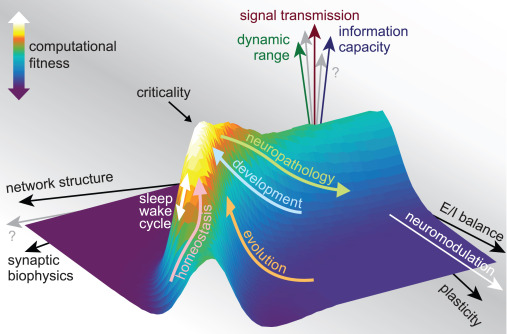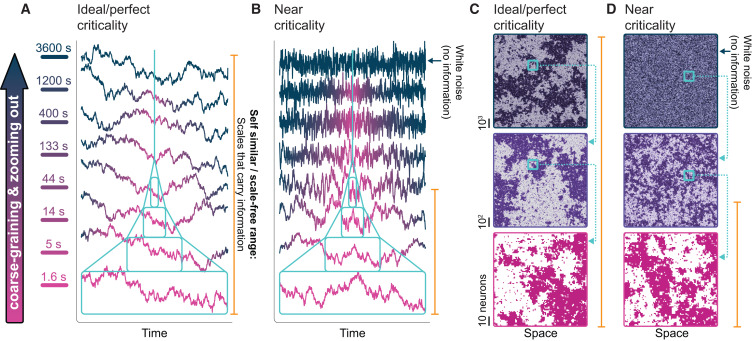Is criticality a unified setpoint of brain function?
Highlights
- Criticality may be a unifying principle of optimal neural computation
- Criticality is a key endpoint of homeostasis in the brain
- Deviations from criticality correlate with multiple brain disorders and anesthesia
- Conflicting evidence in criticality can be explained by temporal coarse graining
Summary
Brains face selective pressure to optimize computation, broadly defined. This is achieved by mechanisms including development, plasticity, and homeostasis. Is there a universal optimum around which the healthy brain tunes itself, across time and individuals? The criticality hypothesis posits such a setpoint. Criticality is a state imbued with internally generated, multiscale, marginally stable dynamics that maximize the features of information processing. Experimental support emerged two decades ago and has accumulated at an accelerating pace despite disagreement. Here, we lay out the logic of criticality as a general computational endpoint and review experimental evidence. We perform a meta-analysis of 140 datasets published between 2003 and 2024. We find that a long-standing controversy is the product of a methodological choice with no bearing on underlying dynamics. Our results suggest that a new generation of research can leverage criticality—as a unifying principle of brain function—to accelerate understanding of behavior, cognition, and disease.
Intro
Consider that the principles that allow for flexible computation are intrinsically destabilizing. Mechanisms of learning and memory—Hebbian plasticity—operate by positive feedback. Left unchecked, LTP and LTD (mechanisms of associative plasticity) lead to catastrophic saturation or silence, respectively, at the circuit level.1,2,3,4,5 In simple terms, a brain that can learn requires some form of active stabilization. Known mechanisms of homeostatic plasticity—cellular and synaptic—are well positioned to counteract these destabilizing forces.6,7,8,9,10,11,12 However, our understanding of such homeostatic mechanisms is to some extent arbitrary—there is little a priori reason to predict that a neuron’s mean firing rate should be 3.2 Hz, for example. What determines the variegated setpoints throughout the central nervous system? Ultimately, the target of homeostasis in the brain is behavior; stabilizing a neuron’s firing rate is of little value if it does not contribute to reliable behavior. Because evolution can only select for behavior,13 and because behavior arises from the coordinated activity of millions to billions of neurons, there is a selective pressure for homeostatic processes in the brain to actively maintain an optimal setpoint at the level of population computation that gives rise to behavior.

Figure 1. Criticality: A high point in the computational fitness landscape
Here, we contend that criticality is a unifying computational principle central to brain function and a key endpoint of neuronal homeostatic control. In the next section, we lay out the rationale for our argument and detail the computationally advantageous properties of neuronal population dynamics at criticality. We also carefully consider supporting experimental evidence. After that, we describe eight testable predictions implicated by the criticality hypothesis, and we systematically review two decades of experimental evidence that supports these predictions (a downloadable annotated bibliography for all 320 papers is provided in the supplemental information). Finally, we perform a meta-analysis of prior work, reconciling studies that were long thought to contradict the criticality hypothesis.
Results and discussion
Criticality as a setpoint
Why is criticality well suited to computation? Taken together, four fundamental properties of criticality constitute a basis for general, flexible computation: scale invariance, marginal stability, tunability, and a generative capacity (Figure 1).
Scale invariance
Scale-invariant population dynamics exhibit meaningful structure on all spatial and temporal scales. This broad repertoire of scales is statistically organized like a fractal—if one zooms in or out, the basic character of population activity is self-similar (Figure 2).
Scale invariance confers coordination among neurons not only at the small scales of milliseconds and microcircuits but also at large scales spanning minutes and brain regions and all scales in between these extremes. Importantly, no particular scale dominates; thus, the term “scale-free” is synonymous with scale invariant. By contrast, consider a system defined by a particular scale. Zoom in or out, and the signal will become noise. In this case, information is only embedded in a specific window of time and only across a limited spatial range. Scale invariance strikes a balance between integration, which requires large-scale coordination, and segregation, which requires the opposite.

Figure 2. Scale invariance/self-similarity in both time and space
source: Is criticality a unified setpoint of brain function?
#brain #scales #fractal #criticality #brainNetworks #dynamics